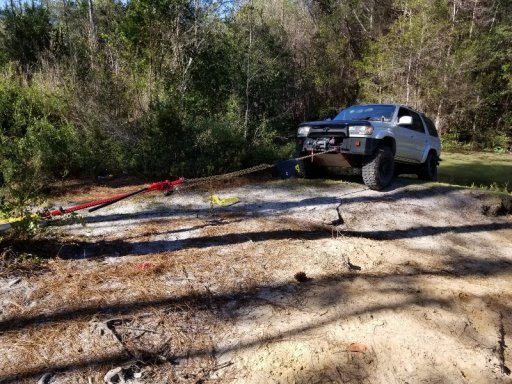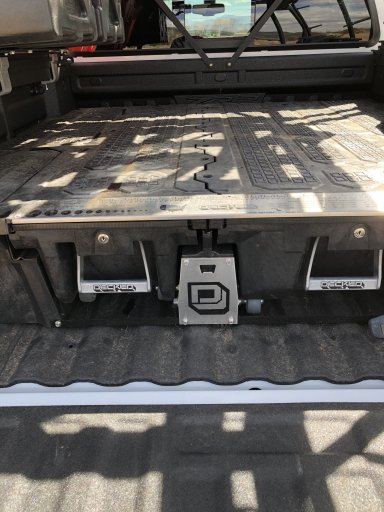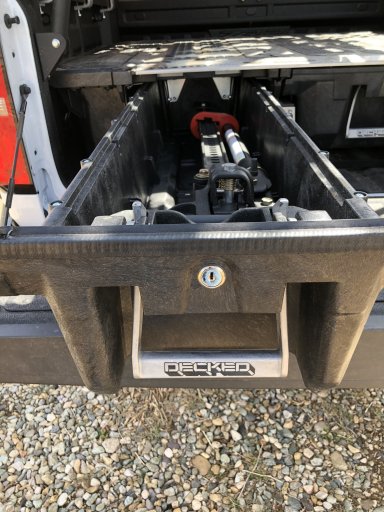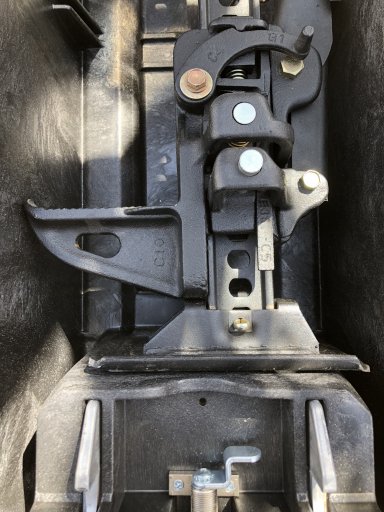
Member III
I posted this in an old thread of mine, but I thought I'd make it into its own thread.
First, I think it is fair to articulate some of the pros and cons of the hi-lift winching kit vs an electric winch:
Hi-lift
-Pros:
1) If you already have a hi-lift, it only takes a modest amount of extra gear (as little as perhaps 25 pounds) to make it winch capable.
2) Requires only $75-200 to buy or build a kit.
3) Easier to winch in multiple directions (including backwards) with the hi-lift.
4) Doesnt have to stay on the vehicle for daily drivers who dont want an extra 100+ lbs on their vehicle.
Cons:
1) It can be physically demanding.
2) It is much slower than an electric winch.
3) It is arguably less safe--or, perhaps, less dummy-proof--than an electric winch.
4) You'll spend an extra several minutes setting a land anchor, if you need to go that route.
Electric Winch:
Pros:
1) Convenient and quick for casual recoveries without requiring another capable vehicle.
2) Provides an opportunity to apply a large amount of force without some arguable dangers of using the kinetic energy of another vehicle + snatch strap.
Cons:
1) Can be expensive (especially if it is the sole reason for an aftermarket bumper).
2) Difficult to pull other than from the front.
Anyways,
I got a chance to do a basic comparison test between winching with the hi-lift and winching with an actual winch.
Bottom Line Up Front:
Including setup and tear-down, I spent 13 minutes with the hi-lift recovery versus about 4.5-5 minutes with the winch
I backed my vehicle over the steep side of a creek to simulate being stuck (though, I am honestly not sure Id have been able to climb out on my own with my current open diffs, heh). Then, I winched myself out both with my hi-lift, and with a single-line pull from my Smitty.
It took two complete runs of the hi-lift mechanism up the beam to ensure I was fully out of the creek.
Finding 1: The setup and tear-down of the jack winching kit adds about 3 or 4 total minutes to the actual recovery process (removing the jack and chains, assembling the kit, then putting it all back in place), versus about 60-90 seconds to pull out the winch remote and unspool the cable. This does not count setting up the anchor end.
Finding 2: The actual winching process took less than 1 minute for the Smitty, vs about 6 for the hi-lift. This checks with an estimated 12-14 FPM for the winch with a middle-weight load, and about 1.5-2fpm for the hi-lift.
Finding 3: Yes, winching with a hi-lift is pretty hard work! I do have a 25'x3/8 synthetic winch extension line coming tomorrow so that I could use it with my snatch block and the jack. This would theoretically allow me to winch up to 12 ft with half the bodily strain, but would require a good bit of care in rigging to put everything in the right place. Of note, understanding how the jack works, I did not need to be or feel like I was in a position where I could have been hurt by the handle (I find it much easier to get into such a potentially-dangerous position while vertically lifting a vehicle).
Conclusion: Inconclusive, for me at least. For just goin' out a'wheelin', the winch seems to add a lot of convenience when you are deliberately attacking obstacles. However, I will say, every time I have used it in the last couple weeks since the install, (twice to rescue a friend and once to drag a fallen tree off the trail), I could have just as easily, [more] quickly, and safely used my snatch straps and winch extensions. Thus, if one is conservative enough when wheeling to not do hard obstacles alone, then I still think one could get by with a decent set of recovery straps and a hi-lift winching kit.
I guess, really, now owning and having compared the two options, I still wouldnt place the electric winch any higher on my list of priorities. And, honestly, I am still debating whether to keep it on there at all (mostly because the line got a nice kink on the 2nd wrap during its 2nd recovery, which means I need to replace the line). Part of me is honestly interested in selling it to put toward a Pull-Pal.
Also of note, I really wish Id have used 5/16 chain instead of 3/8 chain. It is a joke how much people stress about working load limit on shackles and chains, but then use a 5/16 steel cable with a real WLL of about 2500lbs just because its breaking strength is usually around 10k (and thus technically higher than the winch motor!...). Anyways, 5/16 G70 chain has a WLL of over 4500lb, and a minimum breaking strength of almost 19,000 lbs. So yeah, Id have been totally fine with 5/16 chain, especially since I dont use it for vehicle-to-vehicle recoveries. It would then take up a bit less storage space and weigh 15lbs less than my current 3/8 chain (a bigger deal when hailing it out of a stuck vehicle).
Picture is about half way through the hi-lift recovery. Both times, I started with the gas tank skid touching the edge of the bank and the rear bumper partially submerged.

First, I think it is fair to articulate some of the pros and cons of the hi-lift winching kit vs an electric winch:
Hi-lift
-Pros:
1) If you already have a hi-lift, it only takes a modest amount of extra gear (as little as perhaps 25 pounds) to make it winch capable.
2) Requires only $75-200 to buy or build a kit.
3) Easier to winch in multiple directions (including backwards) with the hi-lift.
4) Doesnt have to stay on the vehicle for daily drivers who dont want an extra 100+ lbs on their vehicle.
Cons:
1) It can be physically demanding.
2) It is much slower than an electric winch.
3) It is arguably less safe--or, perhaps, less dummy-proof--than an electric winch.
4) You'll spend an extra several minutes setting a land anchor, if you need to go that route.
Electric Winch:
Pros:
1) Convenient and quick for casual recoveries without requiring another capable vehicle.
2) Provides an opportunity to apply a large amount of force without some arguable dangers of using the kinetic energy of another vehicle + snatch strap.
Cons:
1) Can be expensive (especially if it is the sole reason for an aftermarket bumper).
2) Difficult to pull other than from the front.
Anyways,
I got a chance to do a basic comparison test between winching with the hi-lift and winching with an actual winch.
Bottom Line Up Front:
Including setup and tear-down, I spent 13 minutes with the hi-lift recovery versus about 4.5-5 minutes with the winch
I backed my vehicle over the steep side of a creek to simulate being stuck (though, I am honestly not sure Id have been able to climb out on my own with my current open diffs, heh). Then, I winched myself out both with my hi-lift, and with a single-line pull from my Smitty.
It took two complete runs of the hi-lift mechanism up the beam to ensure I was fully out of the creek.
Finding 1: The setup and tear-down of the jack winching kit adds about 3 or 4 total minutes to the actual recovery process (removing the jack and chains, assembling the kit, then putting it all back in place), versus about 60-90 seconds to pull out the winch remote and unspool the cable. This does not count setting up the anchor end.
Finding 2: The actual winching process took less than 1 minute for the Smitty, vs about 6 for the hi-lift. This checks with an estimated 12-14 FPM for the winch with a middle-weight load, and about 1.5-2fpm for the hi-lift.
Finding 3: Yes, winching with a hi-lift is pretty hard work! I do have a 25'x3/8 synthetic winch extension line coming tomorrow so that I could use it with my snatch block and the jack. This would theoretically allow me to winch up to 12 ft with half the bodily strain, but would require a good bit of care in rigging to put everything in the right place. Of note, understanding how the jack works, I did not need to be or feel like I was in a position where I could have been hurt by the handle (I find it much easier to get into such a potentially-dangerous position while vertically lifting a vehicle).
Conclusion: Inconclusive, for me at least. For just goin' out a'wheelin', the winch seems to add a lot of convenience when you are deliberately attacking obstacles. However, I will say, every time I have used it in the last couple weeks since the install, (twice to rescue a friend and once to drag a fallen tree off the trail), I could have just as easily, [more] quickly, and safely used my snatch straps and winch extensions. Thus, if one is conservative enough when wheeling to not do hard obstacles alone, then I still think one could get by with a decent set of recovery straps and a hi-lift winching kit.
I guess, really, now owning and having compared the two options, I still wouldnt place the electric winch any higher on my list of priorities. And, honestly, I am still debating whether to keep it on there at all (mostly because the line got a nice kink on the 2nd wrap during its 2nd recovery, which means I need to replace the line). Part of me is honestly interested in selling it to put toward a Pull-Pal.
Also of note, I really wish Id have used 5/16 chain instead of 3/8 chain. It is a joke how much people stress about working load limit on shackles and chains, but then use a 5/16 steel cable with a real WLL of about 2500lbs just because its breaking strength is usually around 10k (and thus technically higher than the winch motor!...). Anyways, 5/16 G70 chain has a WLL of over 4500lb, and a minimum breaking strength of almost 19,000 lbs. So yeah, Id have been totally fine with 5/16 chain, especially since I dont use it for vehicle-to-vehicle recoveries. It would then take up a bit less storage space and weigh 15lbs less than my current 3/8 chain (a bigger deal when hailing it out of a stuck vehicle).
Picture is about half way through the hi-lift recovery. Both times, I started with the gas tank skid touching the edge of the bank and the rear bumper partially submerged.

Last edited:







